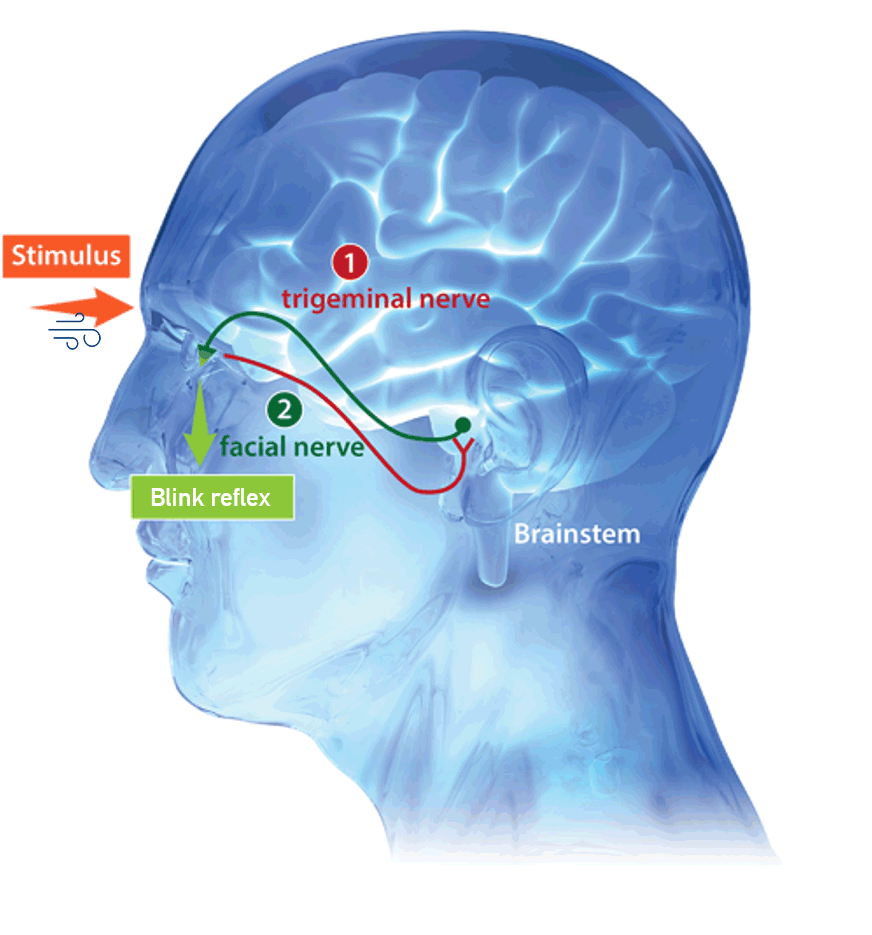Evolution of Technology

1st Generation Device
The Gen 1 blink reflexometer was invented at the Medical University of South Carolina (MUSC). It consisted of a mask, a housing unit, a stimulation system, a camera, an external controller and processor, and a user interface. Tubing connected to the left end of the housing unit delivers a puff of compressed air to the subject’s eyes.
2nd Generation Device
Same as Gen1 but with 3D printed housing unit and mask


3rd Generation Device (EyeStat)
Commercial version of the Blink Reflexometer, called EyeStat. Portable, 5.5lbs, operated on a tripod.
4th Generation EyeStat
Smaller, lighter version of Gen3 utilizing a head strap instead of a tripod.


5th Generation Device (EyeStat5)
The computer, cameras, lights, fans and more were removed from Gen4, and replaced with a spot for a mobile device. The mobile device will run the blinkcns app where a test can be initiated. The app runs all image capturing, processing, etc.
How the Blink Technology Works
Rapid Results
Using a proprietary algorithm, 100 parameters of the blink reflex are measured. A comprehensive medical record is generated for review by a clinician.
7,200 Frames
High-resolution cameras record the blink reflex at 240 frames/sec, capturing 7,200 objective data points in 30 seconds.
Cloud Storage
Over 30 seconds, eight light puffs of air are delivered to the corner of the eye, stimulating the blink reflex.
Cloud Storage
Results and data are transferred and stored in the encrypted Cloud Portal for access and analysis at any time.
Under 3lbs
A portable and battery-operated device, EyeStat can be operated anywhere with ease.
EyeStatTM
FDA-cleared technology indicated to measure and assess the eye blink reflex
The Blink Reflex
Blinking is a reflexive nervous system response.
Damage (trauma or disease) to the brain will cause a change in the corneal blink reflex.
The eye blink reflex is a biomarker of brain function used in the diagnosis and assessment of neurological diseases and conditions.

The blink reflex involves two cranial nerves, the trigeminal (V) and facial (VII) nerves, routing through the medulla and pons in the brainstem.
The trigeminal nerve, when stimulated, sends a message directly to the brainstem. The message is translated, and the brain’s response is transmitted back through the brain to the facial nerve (and, in turn, to the muscles controlling the eyelids). The result is the blink reflex.
What is Measured
Objective medical data in the blink of an eye: 15 Parameters
Elapsed time between the application of the stimulus and the detection of the blink onset
Time difference between the onset of the ipsilateral and contralateral response
Time difference between when the ipsilateral and contralateral eyes moved 30 pixels below their respective tonic positions
Average eyelid velocity over the first 7 frames of the blink
Elapsed time between the detection of the onset of the blink and the eyelid reaching a closed position
Elapsed time between the eyelid reaching a closed position and the eyelid returning within threshold of the tonic position
Elapsed time between the eyelid reaching a closed position and the eyelid moving more than 20 pixels back towards the tonic position
Number of direction changes experienced by the eyelid between stimuli
Average oscillation rate of the eyelid between stimuli
Number of blinks performed by the eyelid between stimuli
Average blink rate of the eyelid between stimuli
Area under the curve of the trajectory of the eyelid between the onset and completion of the blink
Maximum velocity of eyelid between the detected onset of the blink and the eyelid reaching the closed position
Maximum velocity of eyelid between the eyelid reaching the closed position and the eyelid returning within threshold of the tonic position
Difference in pixel position between the tonic position and the location of the eyelid when it reaches a closed position




